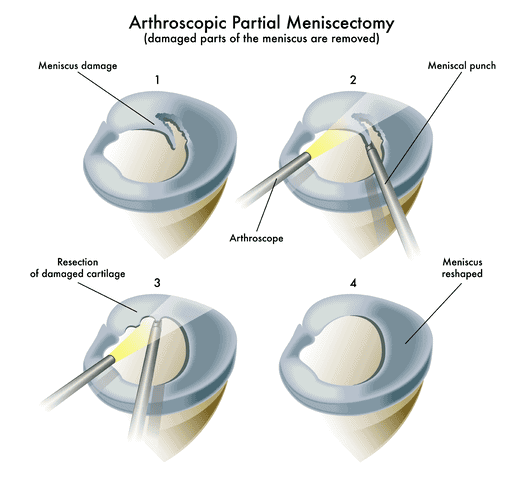Meniscus Tear: Causes, Symptoms, And Treatment Options

Medically Reviewed By:
The meniscus is a C-shaped piece of cartilage in the knee that cushions the thigh bone (femur) and shinbone (tibia). Tears may occur due to injury or age-related degeneration, leading to pain, swelling, and knee instability.
While surgery is often recommended for meniscus tears, approximately 41.3% of these tears occur in the “red zone,” a region rich in blood vessels that can support natural healing.
Procedures using Regenexx injectates utilize interventional orthobiologics to support the meniscus’s natural healing capacity, offering patients a less invasive alternative to surgery for improving knee health and function.
What Is A Torn Meniscus?
The knee is a complex joint that connects the thigh bone (femur), shinbone (tibia), and kneecap (patella). Ligaments and tendons stabilize these bones, playing a crucial role in mobility and stability by redistributing loads and forces.

Various connective soft tissues protect the joint’s bones from friction and damage. These include the menisci. These are two C-shaped discs of cartilage located between the femur and tibia. Each knee has two menisci: the medial meniscus on the inner side and the lateral meniscus on the outer side.
The menisci act as shock absorbers. They distribute weight across the knee joint during walking, running, and jumping. They also aid in joint stability and ensure smooth knee movements.
A meniscus tear occurs when these fibrocartilage fibers are damaged. It can happen due to an abrupt twist or impact. These are often seen in sports or activities involving sudden changes in direction or contact.
Menisci can also suffer age-related degeneration. Repetitive movements and ongoing stress can wear down these cartilage cushions. Over time, this makes them more prone to tears and damage.
When a meniscus tears, the fibrocartilage fibers separate, creating jagged edges that can catch within the joint. This leads to pain, swelling, and sometimes the sensation of the knee “locking” or “giving way.”

Meniscus tears affect up to 14% of the population, especially athletes and aging adults, and account for 50% of all knee injuries.
Types Of Tears In The Meniscus
Meniscus tears are classified in grades based on their size and symptom intensity. Grade 1 tears are minor, often causing mild symptoms. Grade 3 tears are severe or complete tears that may cause significant pain, swelling, and restricted knee movement.
They can also be categorized based on the location and pattern of the tear:

Intrasubstance Tear (Incomplete)
Intrasubstance tears occur within the body of the cartilage. They don’t tend to extend to the surface of the meniscus. This type of tears is often seen in menisci affected by degenerative wear-and-tear. They may not cause immediate symptoms but can progress over time.
Horizontal Tear (Longitudinal)
A horizontal tear runs parallel to the upper surface of the tibia, the tibial plateau. This type of tear splits the meniscus into upper and lower sections. These tears are typically caused by shear stress, which occurs when different parts of the cartilage are pulled in opposite directions, such as during knee twisting.
These injuries can be symptomatic if they extend and form flap or bucket-handle tears (more on these below).
Radial Tear (Transverse)
Radial tears extend from the inner part of the meniscus towards the outer edge. These tears disrupt the circumferential fibers. Circumferential fibers are collagen fibers arranged in circular patterns that help distribute loads and provide structural strength to the meniscus. Tearing or disruption of these fibers often leads to significant knee instability.
Flap Tear
In flap tears, a portion of the meniscus becomes loose and displaced. This creates an uneven fragment within the meniscus that can catch or lock within the knee joint. These injuries are often symptomatic, causing pain and clicking sounds during movement.
Bucket-Handle Tear
Bucket-handle tears are among the most common meniscus tears, accounting for over 30% of such injuries. They are also a severe form of a longitudinal tear, occurring when a portion of the meniscus becomes displaced into the joint. They are named after the characteristic form of the tear, which resembles a bucket handle.
Bucket-handle tears are common in athletes who twist their knees or land awkwardly and forcefully on one leg. They typically cause knee locking and dysfunction. They can also prevent full extension and limit the range of motion.
Complex Tear
Complex tears involve multiple tear patterns within the same meniscus. They can combine features of horizontal, radial, and oblique tears. These tears usually result from significant trauma or advanced degeneration. They are often associated with other knee injuries like ACL tears. They are usually more challenging to treat.
Oblique Tear
Oblique tears are diagonal in the meniscus, often caused by twisting motions or sudden directional changes. These tears can produce cartilage flaps that interfere with knee movement and lead to pain, swelling, and occasional joint locking.
Oblique tears may overlap with other tear patterns, making diagnosing them more complex.
Symptoms Of A Torn Meniscus
Individuals with a torn meniscus may experience knee pain, swelling or mechanical limitations. Symptoms can vary widely; some may have constant or intermittent pain, while others may have none. If the meniscus tear does not cause knee locking, many people can continue daily activities without pain.
Pain Along The Joint Line
Pain along the knee joint line, where the femur and tibia meet, is a key sign of a meniscal tear. Several mechanisms contribute to this pain:
- Nerve Damage: A knee injury can damage or compress surrounding nerve endings. These send distress signals to the brain to prevent further injury, which is felt as pain.
- Inflammatory Response: The body triggers an inflammatory response to contain the injury and heal. This response involves releasing chemicals like prostaglandins and cytokines that make nerves more sensitive. This aggravates swelling, redness or hyperpigmentation, and pain.
- Chronic Inflammation: Normally, inflammation subsides as the injury heals. However, low-grade inflammation can persist even after the knee has healed, leading to chronic pain along the joint line. Risk factors for chronic knee pain include previous knee injuries, having a high BMI, being female, having older age, and exposure to repetitive stress.
In one study, 61% of subjects with meniscus tears in their knees had not had any pain, stiffness, or aching. However, possible symptoms that may indicate a meniscal tear and warrant a diagnosis include:
- Swelling Or Stiffness In The Knee: Swelling, or effusion, occurs when the torn meniscus triggers an inflammatory response. This causes the body to build up fluids like plasma within the joint. This fluid buildup begins to appear within a few hours post-injury. It can increase pressure in the injured area, resulting in stiffness, restricted movement, and, sometimes, a sensation of warmth.
- Feeling As If The Knee Is Collapsing Under Its Own Weight: Instability presents with sensations of the knee buckling or giving way during movement. It can be more noticeable when bearing weight or changing direction. It occurs because the damaged meniscus prevents proper load distribution and stability.
What Causes The Meniscus To Tear?
Meniscus tears fall into two main groups: acute and degenerative tears.
Acute tears often result from an injury involving a sudden force or twist to the knee. Degenerative tears develop over time. They are usually due to the aging process, which weakens the meniscus and makes it more prone to tearing.
Knee Injuries
Knee injuries are one of the leading causes of meniscus tears. They can occur due to:
- Sports injuries. Many acute meniscus tears occur during sports. They are especially prevalent in sports that involve pivoting, sudden stops, or direct contact. These include football, basketball, and soccer. However, even non-contact sports like tennis or skiing can increase the risk because of the sudden changes of direction they involve.
- Sudden twists or rotations. Menisci can tear due to shear forces when different parts of the cartilage are pulled in different directions. This can happen due to sudden and forceful twists, pivoting motions, or knee rotations. These movements strain the meniscus beyond its capacity. A misstep or landing awkwardly on one leg can also lead to a meniscus tear.
Meniscus tears often occur alongside other knee injuries. The most common ones are anterior cruciate ligament (ACL) tears. One study also found that experiencing an ACL tear can increase the risk of subsequent meniscus tear by 22% to 86%.
Aging
Aging can hurt several components of the joint, including the meniscus. When the body’s ability to regenerate tissues decreases with age, the meniscus can become thinner, worn down, brittle, and more likely to tear.
Aging-related degeneration affects everyone. However, some factors can accelerate the rate of wear and tear. These include:
- Obesity
- Smoking
- Activities and professions that place repetitive stress on the knee, such as lifting, jumping, pivoting, etc.
- Poor posture
- Certain anomalies in the structure of the knee, such as:
- Being born with thinner cartilage
- Having bow legs (“genu varum”) or knock knees (“genu valgum”)
- Certain chronic or degenerative conditions, like osteoarthritis. One study found that 60-90% of patients with osteoarthritis show MRI evidence of meniscus tears.
Can A Torn Meniscus Heal On Its Own?
Yes, the meniscus is a living tissue, and its parts have good blood circulation. Tears in those areas heal best.
However, some factors can influence its ability to heal:
- Location of the tear. The meniscus has three zones: red, red-white, and white. Tears in the red and red-white zones can heal on their own. They account for the majority of meniscus tears.
- Red zone: This outer edge of the meniscus has a rich blood supply. It is capable of healing.
- Red-white zone: This middle section has less blood supply. Its healing is slower but possible.
- White zone: This inner part lacks blood supply. Tears here are not expected to heal on their own and may need additional intervention.
- Size of the tear: Smaller tears have a higher chance of healing on their own. This is especially true when knee locking or fragments are not in the joint space. Larger tears may hinder movement and blood flow, complicating the healing process.
- Other factors: These include the age of the patient, history of previous tears and knee injury, and the presence (or absence) of degenerative conditions like osteoarthritis.
Physical therapy can be effective in healing some tears. However, frequently, the body needs support to facilitate and speed up the process. That’s where the Regenexx approach, which uses interventional orthobiologics, comes in.
Conventional Treatment Recommendations For A Torn Meniscus
Conventional treatments for a torn meniscus aim to ease pain and improve range of motion. In cases of severe meniscus tears, additional treatment may be necessary.
- RICE Method: The RICE (rest, ice, compression, and elevation) method is often the first line of treatment. Resting the knee prevents further strain, while ice may help reduce inflammation. Compression in a bandage or knee brace may also help stabilize the joint. Elevation reduces the accumulation of fluids and, in turn, swelling. This method is a staple in the treatment of several knee conditions. However, new research suggests that extreme icing and reducing the blood supply to the site of injury may slow down healing.
- Non-Steroidal and Inflammatory Drugs (NSAIDs): Nonsteroidal anti-inflammatory drugs (NSAIDs) help reduce pain and inflammation in conditions affecting joints, muscles, and the spine. While they provide temporary relief, prolonged use may increase heart, kidney, and gastrointestinal risks, requiring careful management. Read More About NSAIDs.
- Surgery: Surgery may be considered if other treatments have failed or the tear is severe enough to cause disability. Possible surgical interventions for meniscus tears include:
- Partial meniscectomy: This procedure involves removing the damaged portion of the meniscus.
- Meniscus repair: This surgery involves stitching the torn meniscus pieces back together. This encourages healing while preserving the meniscus tissue as much as possible.
- Meniscus transplantation: This surgery is performed when the meniscus is extensively damaged or removed. A donor meniscus may be transplanted to restore joint cushioning.

These surgical interventions are complex and carry severe risks. These include infection, blood clots, and damage to nearby knee components. Additionally, one study found that around 19% of surgical interventions for meniscus tears fail within five years, requiring follow-up and revision surgery.
Why Consider Avoiding Meniscus Surgery?
Research shows that surgery for a torn meniscus is often overprescribed and, in some cases, no more effective than physical therapy. Unfortunately, patients are not always informed of the low success rate of these procedures.
Whether patients undergo a partial meniscus “clean-up” (a piece is surgically removed) or a complete meniscectomy, these procedures may alter knee biomechanics and increase the risk of developing knee arthritis over time.
Torn Meniscus Recovery Time Without Surgery
Knee surgeries may require months of recovery that sometimes involve painful rehabilitation processes to regain strength and function. The exact length of this recovery varies with the type and severity of the tear, the procedure performed, and the patient’s health status. For example, research found that recovery is significantly worse among knee replacement patients than in knee arthroscopy.
Procedures using Regenexx injectates may provide a non-surgical option to help maintain the healthy, cushioning environment the meniscus provides for the knee. Recovery time is typically shorter than with surgery. Many patients can resume their normal daily activities within weeks and return to more physically demanding activities, including sports, within a few months.
Regenexx For Your Torn Meniscus
The Regenexx approach provides a non-surgical path to recovery for those suffering from a torn meniscus by supporting the body’s natural ability to heal with interventional orthobiologics, offering an alternative to surgery and reducing the need for prescription drugs.
Licensed physicians in the Regenexx network can create custom treatment plans tailored to each patient’s injury. Customized treatment plans may include one or more of the orthobiologics below.
Regenexx SD Injectate
Procedures using Regenexx SD injectate include a patented protocol that utilizes Bone Marrow Concentrate (BMC), which contains the patient’s own mesenchymal stem cells. The cell processing for a Regenexx-SD injectate routinely achieves 20x concentration— far above what non-Regenexx cell processing can achieve.
Regenexx SCP Injectate
Procedures using Regenexx SCP injectate represent a supercharged version of platelet-rich plasma (PRP). In this process, blood is drawn, then processed to isolate the platelets and growth factors. The growth factors are then purified, concentrated, and injected into the meniscus area using imaging guidance for precision. Regenexx-SCP injectate provides a higher concentration of growth factors compared to typical PRP procedures.
Regenexx PL Injectate
Procedures using Regenexx PL injectate are a highly specialized derivative of platelet-rich plasma (PRP) with a faster and more concentrated release of growth factors compared to typical PRP. The PL injectate is often combined with other orthobiologics such as PRP and bone marrow concentrate.
Before And After Procedure MRI Images
Take a look at the outcomes of a patient who chose to have a procedure using Regenexx injectates instead of surgery. Scroll to the right to see the MRI of the meniscus before treatment and to the left to see the outcome. The BEFORE shows a torn meniscus. Once treated, the area as seen on the AFTER image will look like a dark, diagonal band.
Make The Most Out Of Your Knees With Care
Long-term knee health starts with the right prevention strategies:
- Regular exercise. Especially low-impact activities like swimming can help strengthen the muscles around the knee and support the joint structure. Avoiding high-impact activities, especially after experiencing a knee injury, can reduce the risk of re-injury.
- Stability and flexibility exercises. Activities like yoga or stretching can help reduce the risk of strains.
- Maintaining a healthy weight. People with obesity or a high BMI may put their knees under excessive stress. This increases the likelihood of risk-factors for joint problems like osteoarthritis and diabetes.
- Proper posture. Correct alignment and form, especially, during sports can support healthy load distribution in the knee.
- Hydration. Staying hydrated helps keep the joints lubricated and the cartilage supple.
The strategies above are important for supporting knee health. However, not all injuries can be prevented. In this case, surgery should not be the first port of call. The meniscus, like other parts of the body, has the ability to heal on its own. Procedures using Regenexx injectates can help enhance this ability to support knee health and recovery without surgery and long term need for prescription medications such as opioids.
Consult with a physician in the licensed Regenexx network to determine if this approach is right for managing your meniscus tear.
Get started to see if you are a Regenexx candidate
To talk one-on-one with one of our team members about how the Regenexx approach may be able to help your orthopedic pain or injury, please complete the form below and we will be in touch with you within the next business day.
References
- Moseley JB, O’Malley K, Petersen NJ, Menke TJ, Brody BA, Kuykendall DH, Hollingsworth JC, Ashton CM, Wray NP. A controlled trial of arthroscopic surgery for osteoarthritis of the knee. N Engl J Med. 2002 Jul 11;347(2):81-8. doi: 10.1056/NEJMoa013259. PMID: 12110735. [Google Scholar]
- Centeno C, Sheinkop M, Dodson E, Stemper I, Williams C, Hyzy M, Ichim T, Freeman M. A specific protocol of autologous bone marrow concentrate and platelet products versus exercise therapy for symptomatic knee osteoarthritis: a randomized controlled trial with 2 year follow-up. J Transl Med. 2018 Dec 13;16(1):355. doi: 10.1186/s12967-018-1736-8. PMID: 30545387. [Google Scholar]

Medically Reviewed By:
